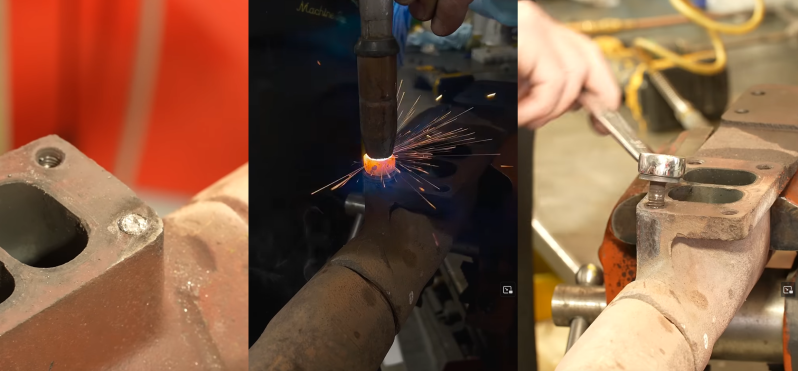If your shop comes complete with a MIG welder, an acetylene torch, and an air hammer, then you have more options than most when it comes to removing broken bolts.
In this short video [Jim’s Automotive Machine Shop, Inc] takes us through the process of removing a broken manifold bolt: use a MIG welder to attach a washer, then attach a suitably sized nut and weld that onto the washer, heat the assembly with the acetylene torch, loosen up any corrosion on the threads by tapping with a hammer, then simply unscrew with your wrench! Everything is easy when you know how!
Of course if your shop doesn’t come complete with a MIG welder and acetylene torch you will have to get by with the old Easy Out screw extractor like the rest of us. And if you are faced with a nasty bolt situation keep in mind that lubrication can help.















If this process interests you then have a look at any of the groups restoring WW2 tanks. It is a very common task to have to remove sheared, corroded or stuck bolts and studs. Also Engels Coach Shop doing the same with 100+ year old metal wagon/coach fittings.
What’s that curry powder? How can you detect cracks with it?
Eat enough curry powder and your body will tell you where your crack is tomorrow morning… 😂
I’d guess it’s just a fine powder rubbed over the casing, and it accumulates in the crack and highlights it.
its called magnafluxing. the powder responds to magnetism, like iron filings do and when the electromagnet is switched on, cracks in the iron are indicated by a break in the magnetic field lines plotted by the powder.
the channel has other videos using it.
Never use an ez-out. It’ll break then god help you. If you don’t have access to a welder or heat source, centre punch and drill is the way to go. If you must try and extractor try a mailable one like those in the style of bluepoint 1020. But if you have them you probably have heat and a welder lol
I was replacing the struts on the daughters car the other day. It is a 2011 toyota camry and the sway bar links connect to the struts. The sway bar links have a nut and the screw that it goes on has a allen hex in the center of it. No matter how much wire brushing and pb blaster or kroil I used i could not get the nut off and the allen hex inevitably stripped out. Boy howdy I do love having torches. Turn on the acetylene and oxygen and less than 30 seconds later the sway link was disconnected. I also agree with Denis comment above!
Link ends are one of those things that I find myself cutting off more than any other part.
Too loose they rattle, too tight they don’t come off. Add in that they are exposed to the worst of the road grime and it doubles the issue.
Just like lower strut/shock bolts…if you are planning on working on it start spraying penetrating oil on it before you even get the car off the ground.
I’ve had great success using an inductive heater to loosen bolts that are not coming off otherwise. Naturally one has to use it before the head comes off.
I finally splurged and bought one of those “bolt buster” heaters. It’s a very niche tool, but it does work. Last time I used it was some manifold collector bolts that wouldn’t move with an air impact.
Blast it with the heater for about 60 seconds and every one came loose. It’s an expensive tool, but it does work.
One of those is on my wishlist, but last I looked, the brandname ones where expensive, and for the ‘hobby priced’ ones, the internet tells me, they often contain a lot of magic smoke.
A thing to note: Any fastener that have now been heat re-treated (flame or induction), must be discarded.
Welding something to the top of a broken bolt has always been enough for me to get it to extract. The heat input and following cooling down is enough to “break” the rusted connection. The second heating of the housing, and the hammering may help, but they have never been needed for me.
Another important part that is easy to skip over is the wiggling back and through @00:50 in the video. This distributes loose rust particles and/or wears down the little tops of the material that actually form the cold welds ans seize. For many, this seems logical, but I’ve seen a few too many video’s on youtube of unscrewing “stuck” things that do not wiggle the nut around at all.
And of course, sometimes there is no alternative, if the tread is really galled up, then destroying one of the parts is the only option. sometimes it drilling out the bolt, other times it’s spending a few hours to remove the nut.
https://www.youtube.com/watch?v=-S6IMTOuLYQ
I’ve done this so many times. I usually weld on a smaller washer. So with an M8 I TIG weld on an m6 washer and weld a nut onto that. makes my life easier, less chance of it wanting to weld against the casing. Best thing is to leave it alone for a while until it’s cooled off entirely otherwise the bolt is hotter than the thing it’s in so it will have grown in size as a result, making it harder to extract. Give it a while, then heat the outside, and you can extract it with ease.
Reminds me of the days I spent with a hand drill removing the remains of the manifold studs of my boat engine.